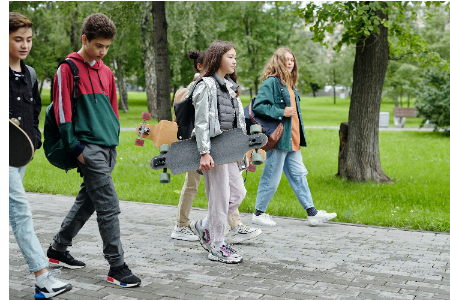
The Walking Bus for Schools project is designed to support and encourage children and young people to walk to school, but could be applied to any community building. Working closely with one school or a cluster of up to four schools, the bus will use fully risk-assessed circular routes within the schools’ catchment areas that participants can join on their way to school. It will use as many quiet streets as possible, avoiding main roads, for safety and to make the route more pleasant and less polluted.
Between February and July, the bus will run once a week (for example, on Fridays) to and from each school, for a total of about 20 trips. Consider the impact of poor weather, school holidays and trips that they may be planning. The intention is for kids and teenagers to look forward to and want to participate in the bus event.
Regular walks encourage physical activity and social interaction, helping those who may be dealing with stress or anxiety. The aim of the bus is to foster a culture of active travel through walking during the project and beyond, involving participants of all ages, increasing the physical health, wellbeing, and mental focus of the whole school community.
Target audience and engagement
- The main target audience for this project are children, young people, parents, carers and teachers
- In coordination with the chosen schools, the project will organise promotional meetings and engage parents and carers at the school gates using word of mouth and flyers. Local publicity and social media will also be utilised. There also will be school assemblies about the project.
Reach
- Medium to large (15 children and 10 parents/carers per school in up to four schools, totalling between 25-100 participants)
- Geographically – anywhere there are safe, green, open spaces, footpaths and walkways, such as parks and quiet streets
Equipment needed
- Printed and/or digital map of the route and pick up points
- Hi-Vis vests
- Waterproof jackets (if needed)
- Advertising materials (posters and flyers)
Resouces needed
- Project Leader:
- Form relationships with community and recruit participants.
- Oversee project, ensure the participants feel safe and enjoy their experience
- Ensure all funding criteria and documentation is met
- Run risk assessment for safeguarding, injuries and to identify any other concerns which may affect project delivery
- Plan and manage the walking routes that will be the Walking Buses
- The project lead should have the requisite level of DBS, understand health and safety needs and preferably be first aid trained (if not another person going on the walks should be first aid trained)
- Ensure health & safety, and safeguarding policies are in place, robust, and adhered to
- Gather feedback from participants and parents/carers to plan for future sessions and projects
- Volunteers:
- Provide support to help run the Walking Bus
- Help participants on the Walking Bus, provide encouragement and answer queries
- Training opportunities for teachers and parents to become volunteers
- Storage Space:
- You will need somewhere to store equipment (Hi-Vis vests and waterproof jackets, etc.). The school/s you are working with may have space. Local councils may be able to provide space or give advice on where to store bikes. Try to keep this as close to the school/s as possible
- Publicity:
- Flyers and posters for publicity of the Walking Bus
Estimated project costs
- Admin, planning and management time £800
- Walking Guide/Project Leader £800-1,000
- Volunteer travel expenses £120
- Printing flyers £160
- Waterproof jackets £975
- Hi-Vis vests £200
- Enhanced DBS checks (if needed) £150 - £200
- Public Liability Insurance (if needed) £170
- Storage (if needed) £350
- Badges (20p x 100) £20
Top tips/Key learnings
- Engage with and listen to every participant; they will provide a valuable insight into how you can improve your project in the future
- Walks should be planned to adapt to participant needs, offering options for less active participants or those who are initially harder to engage
- Revise risk assessments of the routes at intermittent points to ensure walks run safely and more smoothly
- It is good to measure whether the project has encouraged participants to walk more. This is done by a ‘hands up’ survey where participants are asked to confirm or not, certain statements about their view of walking
- Take advantage of the training programme that is offered by Walking and Cycling Grants London
Maximising local contacts
- Engage with any existing community networks you may have to recruit schools
- Utilise networks to get in-kind support (volunteer organisations and local centres, community centres, schools etc.)
This project idea was provided by Transport for London - Twitter - Facebook - Instagram - Youtube
If you decide to run your own version of this project in your community, please email us at wcgl@groundwork.org.uk. We love to hear that we are inspiring people to walk and cycle.